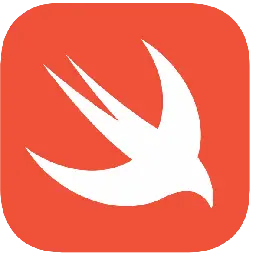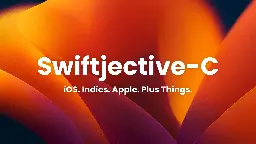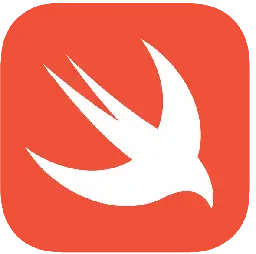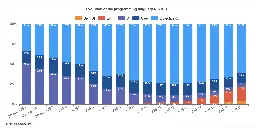But I’m sure the fact Android is FOSS had nothing to do with it, it’s just a random coincidence. It would simply be the most popular OS.
Multiple vulnerabilities affecting the CocoaPods ecosystem, have been discovered, posing a major risk of supply chain attacks.

“E.V.A Information Security researchers uncovered several vulnerabilities in the CocoaPods dependency manager that allows any malicious actor to claim ownership over thousands of unclaimed pods and insert malicious code into many of the most popular iOS and MacOS applications. These vulnerabilities have since been patched.”
Problem is that requires carefully testing, and not every company wants to have a half-assed port that doesn’t have a good experience on the desktop.
Only Brazil is there because it has a big population.
You’re right that garbage collection makes Go simpler, and maybe other patterns do contribute to prevent complexity from piling up. I never worked with Go outside of silly examples to try it out, so I’m no authority about it.
What I meant was more of a “general” rule that the simpler a language is, the more code is necessary to express the same thing and then the intent can become nebulous, or the person reading might miss something. Besides, when the language doesn’t offer feature X, it becomes the programmer’s job to manage it, and it creates an extra mental load that can add pesky bugs (ex: managing null safety with extra checks, tracking pointers and bounds checking in C and so on…).
Also there are studies that show the number of bugs in a software correlate with lines of code, which can mean the software is simply doing more, but also that the more characters you have to read and write, the higher the chance of something to go wrong.
But yeah, this subject depends on too many variables and some may outweigh others.
There’s no free lunch after all. Go’s quick compilation also means the language is very simple, which means all the complexity shifts to the program’s code.
I think when it comes to tooling, some Linux tools are actually BSD software that works because of POSIX compliance. An example is OpenSSH.
This kind of thing can be easily automated nowadays. It’s not really a problem.
That’s a good argument.
And at that point you’ll also have a better idea of the problem and solution.
If I was gonna make a suggestion, it would be to use some formatting tool such as black to make sure your code is styled in a standard way.
I think Lemmy has very few users to have such limitations.
The mental model I have about performance is that the higher abstraction usually beats the lower level abstraction.
So in that sense, a well architected software with proper caching, multithreading where it matters etc. will beat badly architected software (ex: one that brute forces everything). Then, that being equal, good algorithms and solutions beat bad ones. Only then faster runtimes make more of a difference, and at the bottom things like more efficient processor architectures, more efficient compiler etc. beat slower ones.
A good example is Lemmy itself, which as far as I know was made in Rust to be super fast, but then at the beginning was being DDOSed quite easily because of the way the database was designed and lots of queries were very slow. Once they fixed that, Lemmy became actually usable.
“Any improvements made anywhere besides the bottleneck are an illusion” (Gene Kim)
It helps to look up certain concepts in the Wiki (Arch Wiki is probably the most complete and well explained) as you come across them. The idea is to increase knowledge little by little, but over time it compounds.
How a 10 year old design choice for Swift’s type checker still haunts us to this day

“The Swift compiler is notoriously slow due to how types are inferred. Every June I hope that Apple will announce that they fixed it; sadly this is not that year.”
I mean, the way I see it he also has an economic incentive to endorse more AI everywhere.
On the other hand he seems to be one of the people actually pushing for saner legislation.
First thing I install in each platform is fish
Seems like it allows self hosting as well. It seems to have more stuff indeed.
It isn’t a native UI, but the effort made to look native on each platform must be appreciated.
This is very useful. I think I’ll stick with it.
As much as I do like programming in Java, you have a good point.
“An issue introduced by macOS 14.4, which causes Java process to terminate unexpectedly, is affecting all Java versions from Java 8 to the early access builds of JDK 22. There is no workaround available, and since there is no easy way to revert a macOS update, affected users might be unable to return to a stable configuration unless they have a complete backup of their systems prior to the OS update.”
“Now that iOS 17 is available, let’s analyze its built-in apps to answer a few questions: How many binaries are in iOS 17? Which programming languages are used to develop these apps? How many apps are written with Swift? What is the percentage of apps using SwiftUI versus UIKit?”
Hi everyone, I’m excited to announce a new open source project exploring improvements to the testing experience for Swift. My colleagues @briancroom, @grynspan, @chefski, @Dennis and I have been working on this in recent months and have some early progress we're excited to share. Inspired by what’...

In iOS 17, Apple added a range of sensory feedback view modifiers to SwiftUI.

In iOS 17, Apple added a range of sensory feedback view modifiers to SwiftUI removing the need to rely on UIKit.
The #Predicate Macro allows you to filter or search a collection of data using type-safe and readable higher-level Swift code.

#Predicate is a new Macro available since Swift 5.9 and Xcode 15, allowing you to filter or search a data collection. It can be seen as a replacement for the old-fashioned NSPredicate we’re used to from the Objective-C days.
An overview of the different types of charts you can make with Swift Charts - GitHub - jordibruin/Swift-Charts-Examples: An overview of the different types of charts you can make with Swift Charts

An overview of the different types of charts you can make with Swift Charts
Get ready to dive deep into the inner workings of the Objective-C language and runtime! Each post delves into a specific aspect of the language and explores the details of its implementation. I hope you’ll find this valuable to demystify the language, tackle tricky bugs, and optimize your code for p...
Get ready to dive deep into the inner workings of the Objective-C language and runtime! Each post delves into a specific aspect of the language and explores the details of its implementation. I hope you’ll find this valuable to demystify the language, tackle tricky bugs, and optimize your code for performance.
repo: httpsl://github.com/yml-org/YCharts

Y-Charts is a Jetpack Compose-based charts/graphs library that enables developers to easily integrate various types of charts/graphs into their existing UI to visually represent statistical data.
This article will introduce the new features that Core Data has gained in WWDC 2023

Although at WWDC 2023, Apple will mainly focus on introducing the new data framework SwiftData, Core Data, as the cornerstone of SwiftData, has also been enhanced to some extent.
What happens when you set fontSize: 32 in your favorite editor
What happens when you set "font_size": 32 in your favorite editor? I would’ve told you anyway, but I’m glad that you asked.
Let's talk about nutrition, shall we? Wait, what do you mean "Not that type of macros!" 🫘
iOS 17 is out in the wild! As always, let’s check in with our mature interface framework, UIKit.

How type system makes Kotlin so flexible, safe, and intuitive.

The Kotlin type system is amazingly designed. Many features that look like special cases are just a natural consequence of how the type system is designed.
A curated list of awesome Swift Macros. Contribute to krzysztofzablocki/Swift-Macros development by creating an account on GitHub.

Get an overview of what's new in GCC 13, the latest GNU Compiler Collection release, including bug fixes and new features in the C++ front end.

Small improvements that make a big difference in day-to-day coding.

I've been reporting this problem for a long time now, and it's so bad I wonder if I'm just doing something wrong. Radar ID FB11236399. I've just added a much smaller code example that should be fairly easy to test. But generally speaking, Xcode can't inspect local Swift variables, or step over awai...

